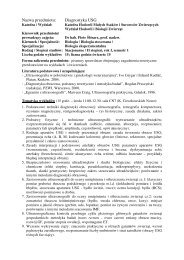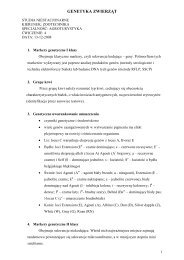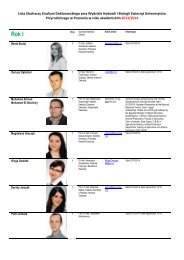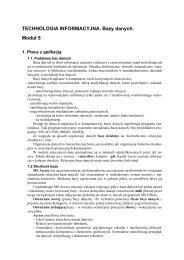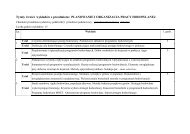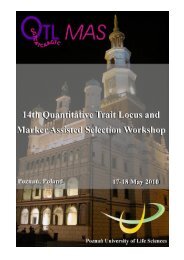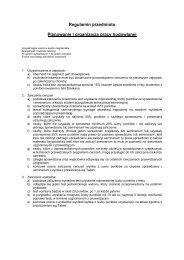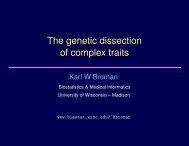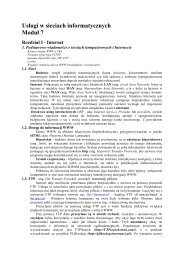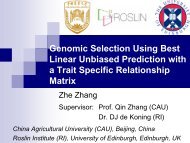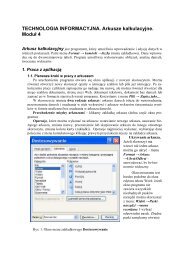Correlation
Correlation
Correlation
You also want an ePaper? Increase the reach of your titles
YUMPU automatically turns print PDFs into web optimized ePapers that Google loves.
Methods for GWA analysis in samples<br />
containing relatives<br />
Yurii Aulchenko<br />
Erasmus MC Rotterdam<br />
QTL/MAS Workshop, May 2010, Poznan<br />
Yurii Aulchenko
Outline<br />
• Samples congaing relatives:<br />
– Human genetically isolated populations<br />
– Any (sub-)total ascertainment (>10% population)<br />
– Animal data<br />
• Reasons for genetic association<br />
• (Genome-Wide) Association analysis in pedigrees<br />
• Recent developments<br />
QTL/MAS Workshop, May 2010, Poznan<br />
Yurii Aulchenko
Reasons for genetic association<br />
What we<br />
see<br />
Phenotype<br />
<strong>Correlation</strong><br />
Genotype<br />
Phenotype<br />
Causation<br />
Genotype<br />
True<br />
model<br />
<strong>Correlation</strong><br />
Confounder<br />
<strong>Correlation</strong><br />
Phenotype<br />
Genotype<br />
QTL/MAS Workshop, May 2010, Poznan<br />
Secondary correlation<br />
Yurii Aulchenko
Confounding in genetic studies<br />
LD<br />
mapping<br />
Causation<br />
Phenotype<br />
Causative variant<br />
Secondary correlation<br />
LD<br />
Marker<br />
genotype<br />
Stratification<br />
QTL/MAS Workshop, May 2010, Poznan<br />
<strong>Correlation</strong><br />
Phenotype<br />
Genetic Population<br />
Secondary correlation<br />
<strong>Correlation</strong><br />
Marker<br />
genotype<br />
Yurii Aulchenko
Genetic origin is a major confounder<br />
Genetic Drift<br />
Selection<br />
Genetic divergence<br />
Chinese<br />
Phenotypic divergence<br />
European<br />
Cultural divergence<br />
QTL/MAS Workshop, May 2010, Poznan<br />
Yurii Aulchenko
Pedigree is a major confounder<br />
Random<br />
segregation and<br />
aggregation<br />
Genetic divergence<br />
Family A<br />
Phenotypic divergence<br />
Family B<br />
Life-style differences<br />
QTL/MAS Workshop, May 2010, Poznan<br />
Yurii Aulchenko
Skin color scan<br />
GWAS of skin color using the HapMap data (European vs African)<br />
QTL/MAS Workshop, May 2010, Poznan<br />
Yurii Aulchenko
Outline<br />
• Reasons for genetic association<br />
• (Genome-Wide) Association analysis in pedigrees<br />
• Recent developments<br />
QTL/MAS Workshop, May 2010, Poznan<br />
Yurii Aulchenko
Genome-Wide Association analysis<br />
• 100,000s markers distributed over the genome<br />
• Each is analysed multiple times:<br />
– Quality control procedures<br />
– Tests for association (including empirical procedures)<br />
• Approximately 10 8 – 10 10 tests to be done<br />
• 1 test per sec.: 30 years<br />
• 15,000 tests p.s.: 20 hours<br />
• Throughput of population-based tests (e.g. GenABEL): ~40,000 t.p.s.<br />
QTL/MAS Workshop, May 2010, Poznan<br />
Yurii Aulchenko
Mixed (polygenic) model<br />
Vector of quantitative phenotype Y<br />
Y = µ + B g + G + e<br />
g: genotype indicator vector g i in {0,1,2}<br />
B: additive affect of the allele<br />
e: is random residual effect ~ MVN(0, Iσ e<br />
2<br />
)<br />
G: is random polygenic effect ~ MVN(0, Φ σ G<br />
2<br />
)<br />
Maximum Likelihood (ML) or Restricted ML (REML)<br />
• Software packages available (MERLIN, QTDT,<br />
SOLAR, ASReml)<br />
QTL/MAS Workshop, May 2010, Poznan<br />
Yurii Aulchenko
Nuclear pedigree<br />
QTL/MAS Workshop, May 2010, Poznan<br />
Yurii Aulchenko
ERF: 3,000 subjects in 20,000 pedigree<br />
QTL/MAS Workshop, May 2010, Poznan<br />
Yurii Aulchenko
Analysis of large complex pedigrees<br />
• ML/REML not feasible: take years for a single GWA<br />
scan to be analysed<br />
• What are the options<br />
– Genomic control (general technique to account for<br />
populational confounding)<br />
– Approximations to ML: FASTA, GRAMMAS, … new staff<br />
QTL/MAS Workshop, May 2010, Poznan<br />
Yurii Aulchenko
Skin color scan<br />
GWAS of skin color using the HapMap data<br />
GWAS without any association<br />
QTL/MAS Workshop, May 2010, Poznan<br />
Yurii Aulchenko
Idea of the genomic control<br />
• Model: Y = µ + B g + e<br />
• There is stratification/pedigree<br />
• Assumption: stratification<br />
acts in the same manner<br />
across all loci<br />
• This leads to uniform inflation of<br />
the test statistics<br />
• The distribution of the test<br />
statistics is λ⋅χ 2 1 (λ≥1)<br />
Assumption holds for confounding<br />
If genetic selection: EIGENSTRAT, SA<br />
QTL/MAS Workshop, May 2010, Poznan<br />
Yurii Aulchenko
Solution 1: ignore G, apply GC<br />
Vector of quantitative phenotype Y<br />
Y = µ + B g + e<br />
Score test for association:<br />
Lambda is estimated using genomic control (GC):<br />
Computation time ~ O(N)<br />
QTL/MAS Workshop, May 2010, Poznan<br />
Yurii Aulchenko
Few notes on GC<br />
When stratification is large (say, λ > 1.1) other, more<br />
powerful methods are to be used<br />
GC assumes that stratification acts in the same<br />
manner across all loci, which is not always true<br />
In present form, works only for additive model<br />
Inflation factor λ depends on samples size. Thus<br />
special methods should be used when number of<br />
people typed for different SNPs is different<br />
Apparently inflation sets the “detectability limit” on the<br />
size of identifiable effect (Holmans’s hypothesis)<br />
QTL/MAS Workshop, May 2010, Poznan<br />
Yurii Aulchenko
FASTA<br />
FAmily Score Test for Association (aka MMSCORE)<br />
Based on the mixed model Y = µ + B g + G + e<br />
FASTA test for association:<br />
(a) Estimate polygenic model Y = µ + G + e<br />
(b) Compute FASTA test<br />
(c) Apply GC afterwards if λ > 1<br />
[extended in recent ProbABEL paper]<br />
Computation time ~ O(N 2 )<br />
QTL/MAS Workshop, May 2010, Poznan<br />
Yurii Aulchenko<br />
Chen & Abecasis, 2007; Aulchenko & Struchalin, 2010
GRAMMAS-GC<br />
GW Rapid Association using Mixed Model And Score test<br />
Based on the mixed model Y = µ + B g + G + e<br />
GRAMMAS test for association:<br />
(a) Estimate polygenic model Y = µ + G + e<br />
(b) Compute environmental residuals<br />
(c) Runs score test on residuals<br />
(d) Apply GC (λ expected to be < 1) => grammas-gc<br />
Computation time ~ O(N)<br />
QTL/MAS Workshop, May 2010, Poznan<br />
Yurii Aulchenko<br />
Aulchenko et al, 2007; Amin et al., 2007
Power comparison<br />
• Part of ERF pedigree<br />
• Associated SNP explained 1, 2 or 3% of variance<br />
• Polygenic effect simulated using MVN distribution<br />
h 2 =30% h 2 =50% h 2 =80%<br />
REML<br />
FASTA<br />
GRS<br />
GC<br />
FBAT<br />
QTL/MAS Workshop, May 2010, Poznan<br />
Yurii Aulchenko
Relationship between genomes<br />
The estimate of kinship between i and j may<br />
be obtained from genomic data:<br />
g ik is the genotype (0, 0.5, 1) of the i-th person at k-th<br />
SNP<br />
p k is the frequency of “1” allele<br />
QTL/MAS Workshop, May 2010, Poznan<br />
Yurii Aulchenko
Genomic vs. Pedigree kinship<br />
• 1,400 ERF people genotyped for 6K Illumina Array<br />
• Trait values simulated based on observed genotypes<br />
• Associated SNPs explained from 0.3 to 4% of variance<br />
h 2 =30% h 2 =50% h 2 =80%<br />
Genomic<br />
Φ Pedigree<br />
Φ<br />
GC<br />
QTL/MAS Workshop, May 2010, Poznan<br />
Yurii Aulchenko
Genomic Φ is better than pedigree Φ<br />
• Pedigree is not<br />
guaranteed to be<br />
correct<br />
– Missing links =><br />
increased type 1 error<br />
• Pedigree relationship<br />
coefficient is the<br />
expected proportion of<br />
genome shared<br />
– Genomic relationship<br />
may better estimate<br />
true sharing<br />
QTL/MAS Workshop, May 2010, Poznan<br />
Yurii Aulchenko
Outline<br />
• Reasons for genetic association<br />
• (Genome-Wide) Association analysis in pedigrees<br />
• Recent developments<br />
QTL/MAS Workshop, May 2010, Poznan<br />
Yurii Aulchenko
Recent developments: even better<br />
GRAMMAR<br />
• Power of GRAMMAR can be brought to the power of<br />
reml/mmscore with “inverse GC”, giving GRAMMAS-<br />
GC. The problem remained that the effect estimates<br />
were biased downwards.<br />
• P. Visscher noticed long time ago that bias seems to<br />
be a simple function of heritability. Apparently we now<br />
can prove that and get unbiased estimates for<br />
GRAMMAR.<br />
QTL/MAS Workshop, May 2010, Poznan<br />
Yurii Aulchenko
Recent developments: FMM<br />
• Existing practical methods are approximate (2-step).<br />
W. Astle and D. Balding have developed fast mixed<br />
models algorithm, which is under implementation in<br />
GenABEL<br />
• Computation time: for all methods, linear with<br />
#markers, with n = #people:<br />
– GRAMMAS-GC ~ O(n)<br />
– MMSCORE ~ O(n 2 )<br />
– new FMM ~ O(n 2 +kn), where k is small (3-10)<br />
QTL/MAS Workshop, May 2010, Poznan<br />
Yurii Aulchenko
Recent developments: binary traits<br />
• Up until now the problem of GWA analysis of binary<br />
traits in samples of relatives was not (practically)<br />
solved. Biggest problem is not a correct p-value, but<br />
rather good effect estimate (Odds Ratio)<br />
• N. Pirastu is working on simple method for analysis of<br />
binary traits; will be implemented in GenABEL in near<br />
future. Speed will be the same as the speed for<br />
analysis of QTs<br />
QTL/MAS Workshop, May 2010, Poznan<br />
Yurii Aulchenko
QTL/MAS Workshop, May 2010, Poznan<br />
Yurii Aulchenko



